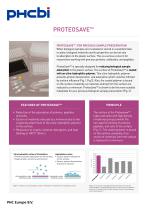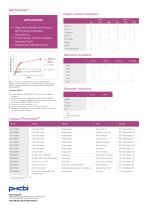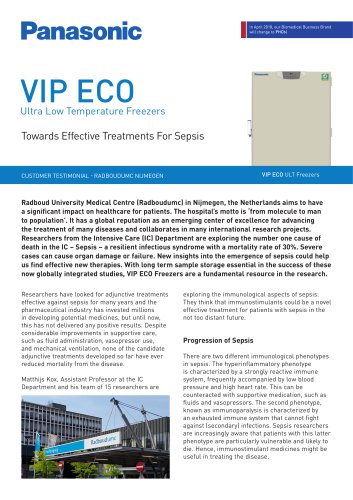 Website:
PHC Europe B.V. / PHCbi
Website:
PHC Europe B.V. / PHCbi
Group: PHC Corporation
Catalog excerpts

PROTEOSAVE™ PROTEOSAVE™: FOR PRECIOUS SAMPLE PRESERVATION When biological samples are incubated or stored in a standard tube or plate, biological materials and its properties can be lost due to adsorption to the plastic surface. This is a serious concern for researchers working with precious proteins, antibodies, and peptides. ProteoSave™ is specially designed for reducing biological sample adsorption to the plastic surface. The surface of ProteoSave™ is coated with an ultra-hydrophilic polymer. This ultra-hydrophilic polymer prevents protein denaturation and adsorption which could be inflicted by surface influence (Fig.1, Fig.2). Also, the coated polymer is bound on the surface covalently, so materials eluting from the surface are reduced to a minimum. ProteoSave™ is shown to be the more suitable tube/plate for your precious biological sample preservation (Fig. 2). PRINCIPLE The surface of the Proteosave™ tubes and wells with high density of hydroxyl groups prevent the non-specific binding of proteins, peptides, and cells to the surface (Fig. 1). The coated polymer is bound on the surface covalently, thus elution of materials from the surface is reduced to a minimum. Reduction of the adsorption of proteins, peptides and cells. Elution of materials reduced to a minimum due to the covalently attachment of the ultra-hydrophilic polymer to the surface. Resistance to organic solvents, detergents, and heat (boiling at 100°C 10min.). Hydrophobic surface • Causes protein adsorption on the surface. • Causes protein denaturation and loss of function. Ultra-hydrophilic surface of ProteoSaveTM • Prevents protein adsorption on the surface. • Keeps protein structure and function. Natural Proteins Denatured Proteins Figure 1. Features of Ultra-hydrophilic surface of ProteoSave™ compared with a hydrophobic surface Hydrophobic surface Tube/Plate surface Ultra-hydrophilic surface Tube/Plate surface Figure 2. The number of peptides detected by nanoLC Ultra 2D with TripleTOF®5600 rom Hep3B digested extracts. (Data Courtesy of Masahiro Kamita, Ph.D , National Cancer Center Research Institute, Chemo
Open the catalog to page 1
PROTEOSAVE™ Organic solvent resistance APPLICATION High value sample preservation like Proteins, Antibodies, Vaccines etc. Protein assay- Enzyme catalysis (example Fig.3). Preparation of dilution series. Reaction efficiency (%) Methods & Material Reaction Containers: PROTEOSAVE™ 1.5mL microtube, Competitor X, Competitor Y Reaction reagent: SGP11 3mM(0.43mg) (TOKYO CHEMICAL INDUSTRY CO., LTD.), Phosphate buffer(pH7.0) 50mM, Endo-M 10mU/mL(0.5mU) (No. A1651, TOKYO CHEMICAL INDUSTRY CO., LTD.) Total Volume:50 μL, Temperature:30 ºC. Reaction timeslot (hours):1st, 2nd, 3rd, 4th, 5th, 6th,...
Open the catalog to page 2All PHC Europe B.V. / PHCbi catalogs and technical brochures
-
Real Time PCR Brochure
8 Pages
-
STEMFULL™ Brochure
2 Pages
-
Cryogenic Vials Brochure
2 Pages
-
iP-TEC® General Brochure
12 Pages
-
PATHFAST™ Presepsin
6 Pages
-
MCO-50AIC-PE CO2 Incubators
2 Pages
-
MCO-50M-PE CO2 Incubators
2 Pages
-
Cleanroom Classification
4 Pages
-
MIR-554-PE Cooled Incubator
2 Pages
-
CO2 & MULTIGAS INCUBATOR SERIES
16 Pages
-
General Catalogue
60 Pages
-
Vaccine Storage E-Book
14 Pages
-
MDF-C2156VANW-PE
16 Pages
-
MDF-DU901VHL-PE
2 Pages
-
VIP Brochure
16 Pages
-
MPR-S150H-PE & MPR-S300H-PE
2 Pages
-
MPR-N450FHD-PE
2 Pages
-
Commitment to PHC Quality
32 Pages
-
PRIMESURFACE®
4 Pages
-
Hybrid Water Cooled Freezers
16 Pages
-
MPR-1014R-PE
2 Pages
-
MPR-N450FH-PE
2 Pages
-
MDF-U731M-PE -30°C Freezer
2 Pages
-
MCO-170AIC-PE CO2 Incubators
2 Pages
-
MLR-352-PE Climate Chamber
2 Pages
-
2018 MIR COOLED INCUBATORS
6 Pages
-
MIR-554 Cooled Incubator
2 Pages
-
MIR-154-PE | MIR-254-PE
2 Pages
-
MCO-170AC-PE CO2 Incubators
2 Pages
-
MCO-230AIC-PE CO2 Incubators
2 Pages
-
MIR Heated Incubators
2 Pages
-
MCO-80IC-PE CO2 Incubator
2 Pages
Archived catalogs
-
MCO-50AICL-PE Co2 Incubator
2 Pages
-
MLS
2 Pages
-
ULTRA LOW TEMPERATURE FREEZERS
16 Pages
-
MCO-5AC-PE CO2 Incubators
2 Pages
-
Incubateurs multigaz
2 Pages
-
Panasonic - Cryopreservation
28 Pages
-
MDF-DU302VX-PE
2 Pages
-
Biological Safety Cabinet
2 Pages
-
TwinGuard ULT Freezers brochure
12 Pages
-
Cooled Incubators
4 Pages
-
MDF-U5386S-PE
2 Pages
-
MDF-U4186S-PE
2 Pages
-
MDF-U3386S-PE
2 Pages
-
MDF-U5412-PE
2 Pages
-
MDF-U731M-PE
2 Pages
-
MBR Blood Bank refrigerators
2 Pages
-
MIR-H163-H263
2 Pages
-
TwinGuard -86 chest freezers
2 Pages
-
Bloodbank Refrigerators
4 Pages
-
MIR Cooled Incubators
4 Pages
-
MPR-S163-PE & MPR-S313-PE
2 Pages
-
Autoclaves MLS-2420/3020
2 Pages
-
Biomedical Freezer MDF-U731M
2 Pages
-
MDF-U500VX-PE
2 Pages
-
MDF-U700VX-PE
2 Pages
-
MIR-162/262
2 Pages
-
Biomedical Freezers
4 Pages


































































![MPR-722[R]-PE | MPR-1412[R]-PE](https://img.medicalexpo.com/pdf/repository_me/70908/mpr-722-r-pe-mpr-1412-r-pe-211757_1mg.jpg)















































































































